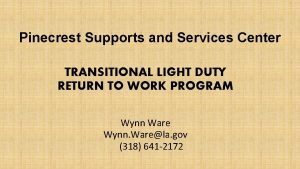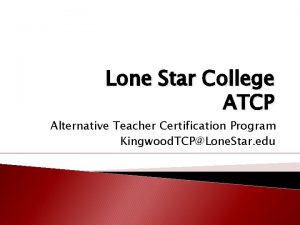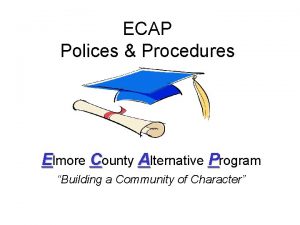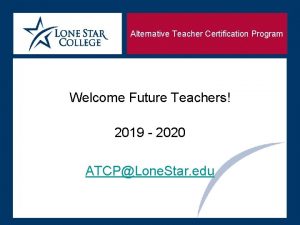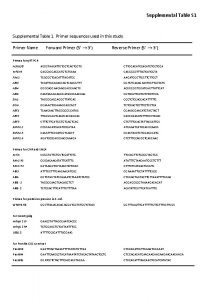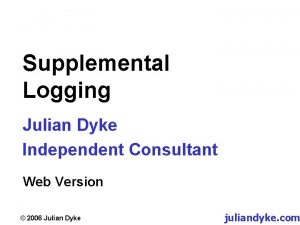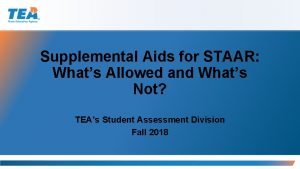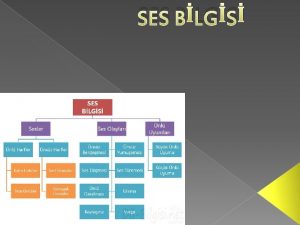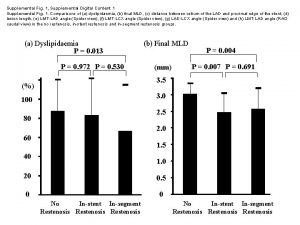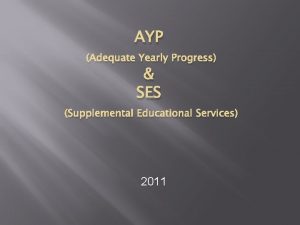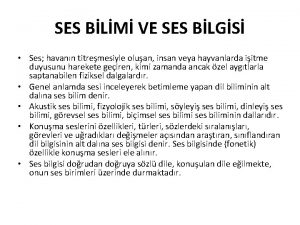SCUSD Supplemental Educational Services SES Alternative Supports Program












- Slides: 12

SCUSD Supplemental Educational Services (SES) Alternative Supports Program 2016 -17 Information for Parents Presented by: Lisa Hayes, Director, State & Federal Programs Kelley Odipo, Coordinator, State & Federal Programs

Changes to the Supplemental Educational Services (SES) Program? • Background: – SES was offered at schools in Program Improvement (PI)Year 2 and beyond and required by Title I law – Free academic tutoring by CDE approved providers paid by district • The California Department of Education (CDE) changed the SES requirements for 2016 -17 – Districts are required to develop new SES programs for 2016 -17 – Academic support can be provided by district or school sites in several different ways – Districts can choose the amount of funding for the program

CDE SES 2016 -17 Transition Plan Guidance • Program must be provided at schools in Program Improvement (PI) Year 2 & beyond • District must set aside a reasonable amount of Title I funds to provide academic support • Academic support must be aligned with daily instruction • Supports are based on and monitored with state or local assessments • May be offered during school hours or before/after school, or summer learning programs

Funding for SES Alternative Supports 2016 -2017 Funding Source = Title I Funding Amount = $2, 200, 000 4

Plan Proposal Implementation Strategies RESOURCE TEACHERS • Certificated academic support resource teachers (current and retired) • Provides intervention directly to students during the school day • Utilizes state and local assessment to monitor student progress • Collaborates with staff to close achievement gaps and develop intervention programs

Planned Implementation Strategies 2. Before/After School Day Interventions: • The school site’s certificated teachers provide interventions before or after the school day or in the summer • A minimum of 2 -3 tutoring sessions per week • Students reassessed every five weeks • Tutoring groups with a maximum of 10: 1 student to teacher ratio • Use of high quality, district approved, CCSS aligned curricular materials 6

Planned Implementation Strategies 3. Summer School Interventions: • The school site’s certificated teachers will provide interventions in a 4 -6 week summer school program • Summer school class sizes will be no more than a 15: 1 student to teacher ratio • Student progress will be continuously monitored and assessed using common assessments • Use of high quality, district approved, CCSS aligned curricular materials 7

Planned Implementation Strategies 4. External Support Providers: • Providers selected in collaboration with school site and district • Tutoring provided for a minimum of 3 sessions a week at the students’ school site • Student to teacher ratio for tutoring groups is a 10: 1 maximum • District assessments used to assess student growth and impact • The district and parents/guardians provided with regular reports of student progress • High quality, district approved, CCSS aligned curricular materials are used • Incentives to schools, students and/or families for services may be provided by External Providers 8

Program Delivery Step 1: Each school will determine which option is best through collaboration with principal and teachers. Step 2: Schools that want a resource teacher will have a position posted. Step 3: Available resource teachers will be hired. Step 4: Schools that do not receive (or want) a resource teacher will implement before/after school tutoring, summer school, or contract with an external provider. Services will provided between February and May, through July for summer programs.

Parent Notification Each school receiving funding is sending home a letter to parents informing them of which option has been chosen.

Required Data and Reporting The district will need to report to CDE at the end of the 2016 -17 school year: • Amount of funding set aside and used • Number of students eligible and served • What instructional strategies were used

QUESTIONS
 Scusd illuminate
Scusd illuminate Oklahoma supplemental online course program
Oklahoma supplemental online course program Pinecrest supports and services center
Pinecrest supports and services center Oklahoma department of career and technology education
Oklahoma department of career and technology education Lonestar teaching certification
Lonestar teaching certification Ecap elmore county
Ecap elmore county Lone star college alternative teacher certification program
Lone star college alternative teacher certification program Juvenile justice alternative education program
Juvenile justice alternative education program Bellerbys educational services limited singapore branch
Bellerbys educational services limited singapore branch Educational services 1bsinghtechcrunch
Educational services 1bsinghtechcrunch Supplementary table 1
Supplementary table 1 Drop supplemental log group
Drop supplemental log group Science staar supplemental aids
Science staar supplemental aids


